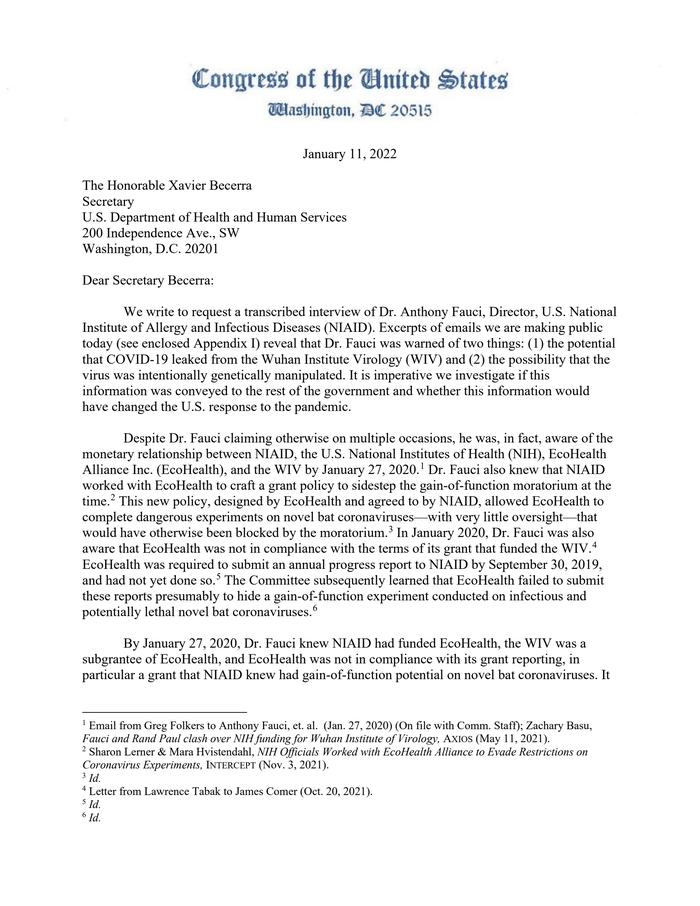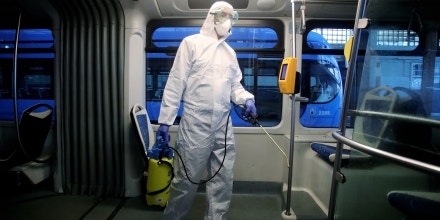"On Tuesday, Republicans on the House Committee on Oversight and Reform released a letter that paints a damning picture of U.S. government officials wrestling with whether the novel coronavirus may have leaked out of a lab they were funding, acknowledging that it may have, and then keeping the discussion from spilling out into public view.
The letter, signed by James Comer, R-Ky., and Jim Jordan, R-Ohio, was followed by pages of notes on emails that were first obtained through the Freedom of Information Act by BuzzFeed News and the Washington Post, but were heavily redacted when published in June 2021. The redacted emails included the agenda for a February 1, 2020, telephone conference between National Institute of Allergy and Infectious Diseases director Anthony Fauci; his then-boss, former National Institutes of Health director Francis Collins; and several of the world’s leading virologists. The communications contained extensive notes summarizing what was said during the call, but their substance was hidden at the time.
Oversight Committee staff were able to view the full emails “in camera,” which means they could physically look at them and take notes but couldn’t take copies with them. The information released Tuesday for the first time reveals the content of notes taken on the February 1 call.

House Oversight letter and email transcriptions16 pages
On that call, virologists Michael Farzan and Robert Garry told Fauci and Collins the virus might have leaked from the Wuhan lab. It might have been genetically engineered, the transcription of Garry’s notes suggests, but this now seems unlikely. Another possibility, put forward by Farzan, was that it could have been evolved in the lab through a process known as serial passage.
“The email is out-of-context,” Garry wrote Wednesday in an email to The Intercept. “This was one email among many I was sharing with my colleagues.”
The two methods represent two different ideas behind the so-called lab-leak hypothesis. The one that gained notoriety early in the pandemic is genetic engineering, where scientists insert and delete nucleotides in the virus’s genetic code, in this case viral RNA, to turn it into something new. This version forms the basis of accusations that the virus was intentionally created as a bioweapon — which practically every credible scientist has dismissed as an illogical conspiracy, but was quickly embraced by former President Donald Trump and much of the American right wing, souring scientists, liberals, and the mainstream on the possibility of lab origin. The less lurid but seemingly more plausible version is the idea of evolution through serial passage, in which scientists allow a virus to jump between host species or cell cultures, spurring new mutations.
The day before the call, Scripps Research infectious disease expert Kristian Andersen had warned Fauci that the virus may have been engineered in a lab, noting that he and several other high-profile scientists “all find the genome inconsistent with expectations from evolutionary theory.” The scientists agreed to have a conference call the next day. “It was a very productive back-and-forth conversation where some on the call felt it could possibly be an engineered virus,” Fauci told Alison Young, writing for USA Today, in June 2021.
Not long after the call, Andersen was the lead author on a paper in Nature Medicine titled “The Proximal Origin of SARS-CoV-2.” The paper proposed “two scenarios that can plausibly explain the origin of SARS-CoV-2: (i) natural selection in an animal host before zoonotic transfer; and (ii) natural selection in humans following zoonotic transfer.” For the scientists and pundits who sought to discount the emerging lab-leak hypothesis, it offered the authoritative proof they needed. The paper has since been accessed more than 5.6 million times, with over 2,000 citations.
The authors acknowledged a third scenario, “selection during passage,” but they discussed it briefly and presented it as by far the least plausible. The newly released notes from the call, however, suggest that the scientists Fauci consulted initially considered that possibility to be much more serious than the paper let on.
On February 2, Jeremy Farrar, an infectious disease expert and the director of Wellcome, sent around notes, including to Fauci and Collins, summarizing what some of the scientists had said on the call. Farzan, a Scripps professor who studied the spike protein on the 2003 SARS virus, “is bothered by the furin site and has a hard time explain that as an event outside the lab (though, there are possible ways in nature, but highly unlikely),” Farrar’s note reads, referring to a spike protein feature that aids interaction with furin, a common enzyme in human lung cells. Farzan didn’t think the site was the product of “directed engineering,” but found that the changes would be “highly compatible with the idea of continued passage of the virus in tissue culture.”
According to the transcribed notes, Garry, a professor at the Tulane University School of Medicine, said on the call that he had aligned the SARS-CoV-2 genome with that of RaTG13, a 96-percent similar virus isolated from bats at the Wuhan Institute of Virology that was long regarded as the new virus’s closest known relative — though a closer one has since been identified. Garry found that the spike proteins of RaTG13 and SARS-CoV-2, which makes the latter so infectious, were nearly identical. The key distinction was in the ability of the new virus’s spike protein to interact with furin, which Garry found too perfect to make natural sense. “I just can’t figure out how this gets accomplished in nature,” he said.
“My initial impression and that of others about the [furin cleavage site] was wrong. I changed my mind with new information/new data,” Garry wrote to The Intercept. “That’s how science works. No one was trying to mislead the public. What was in the Proximal Origins paper was our best analysis — it’s held up extremely well.”
 Read Our Complete CoverageThe Coronavirus Crisis
Read Our Complete CoverageThe Coronavirus Crisis
As they discussed what to present to the public, the scientists determined that questions of potential lab origin might prove more trouble than they’re worth. “Given the evidence presented and the discussions around it, I would conclude that a follow-up discussion on the possible origin of 2019-nCoV would be of much interest,” wrote Ron Fouchier, a virologist at the Erasmus MC Center for Viroscience in the Netherlands, on February 2. Years earlier, Fouchier’s gain-of-function research had brought the discipline under fire for a 2011 experiment in which he infected ferrets in adjacent cages with the avian influenza virus, allowing it to become airborne and infect mammals. “However, further debate about such accusations would unnecessarily distract top researchers from their active duties and do unnecessary harm to science in general and science in China in particular,” Fouchier wrote.
Farzan, Fauci, and Fouchier did not immediately respond to The Intercept’s requests for comment.
Several of the scientists on the email chain ended up co-authoring the Nature Medicine paper with Andersen and Garry. In a February 4 email, which House Republicans presented as a response to a first copy of the draft, Fauci wrote: “?? Serial passage in ACE2-transgenic mice.”
The early draft has not been made public, so we don’t know what, exactly, sparked Fauci’s reaction. But his words, which refer to the process of passaging a virus in “humanized” laboratory mice — or mice that have been genetically modified to express receptors for human ACE2, an enzyme that occurs in the lungs — do not appear in the published paper.
“Neither Drs. Fauci or Collins edited our Proximal Origins paper in any way. The major feedback we got from the Feb 1 teleconference was: 1. Don’t try to write a paper at all — it’s unnecessary or 2. If you do write it don’t mention a lab origin as that will just add fuel to the conspiracists,” Garry wrote on Wednesday.
When the paper appeared in Nature Medicine on March 17, 2020, it noted near the end that in order for the novel coronavirus to have emerged in a lab via serial passage, scientists would have to conduct those experiments using a relative with very high genetic similarity, but there was no evidence that such experiments had been done. The authors added, “Subsequent generation of a polybasic cleavage site,” which lets the virus process furin, “would have then required repeated passage in cell culture or animals with ACE2 receptors similar to those of humans, but such work has also not previously been described.”
Though the paper was publicly embraced by the scientific community and the mainstream media, Collins worried that its impact wasn’t sufficient. “Wondering if there is something NIH can do to help put down this very destructive conspiracy,” Collins wrote on April 16, 2020, in reference to a Fox News segment on the lab-leak theory. “I hoped the Nature Medicine article on the genomic sequence of SARS-CoV-2 would settle this. But probably didn’t get much visibility. Anything more we can do?”
“I would not do anything about this right now,” Fauci replied. “It is a shiny object that will go away in times.”
Update: January 13, 2021
After publication, Robert Garry clarified his previous comments to The Intercept: “One thing that could be misconstrued is that neither Dr Fauci or Dr Collins suggested in any way that we not write the Proximal Origin paper. Likewise, neither one suggested that we not mention the possibilty of a Lab origin. These were comments from others in emails after the call.” The story’s sub-headline has been updated to reflect Garry’s clarification that the advice did not come from NIH officials but from others following the call.
Contact the author:
Maia Hibbettmaia.hibbett@theintercept.com@maiahibbett
Ryan Grimryan.grim@theintercept.com@ryangrim" https://theintercept.com/2022/01/12/covid-origins-fauci-redacted-emails/?utm_medium=social&utm_campaign=theintercept&utm_source=twitter
The allegation that Covid19 was not genetically manipulated is in no wise properly substantiated the author simply resorts to neo-liberal smear tactics (shame on you Intercept).



